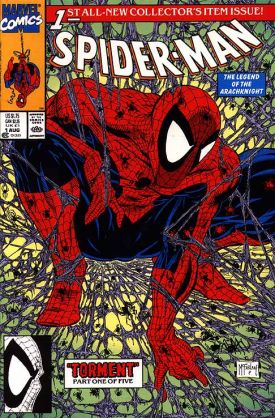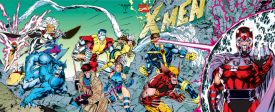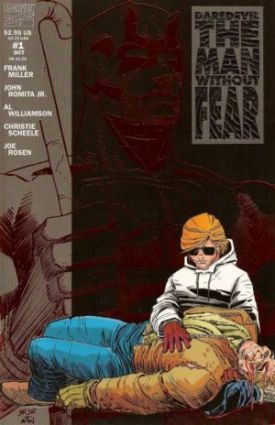Comics /
Spotlight /
Knowledge and Scholarship
Marvel History Part 6 - 1990s Marvel
By Frederic Haddox
August 16, 2008 - 08:36
During the 1990s, the stabilized economy triggered more consumer consumption. People were buying first and thinking later. This premise tended to permeate the speedy rise and fall of the industry. In the beginning of the 1990s, Marvel Comics became the victim of a long series of business dealings that would ultimately lead to its bankruptcy in 1996.
Marvel Comics was bought by New World Entertainment in 1986, putting the company in the hands of Ronald Perelman. The Revlon executive took the company public on the New York Stock Exchange.[1] The positive effect of this was that more Marvel Comics series were coming out and even a few films had come out (direct to video and TV). The downside was that part of the money used for this came from junk bonds Perleman issued. Unfortunately, Perleman’s unsavory reputation was based on this practice and would definitely contribute to Marvel’s demise. [2]
In 1990, McFarlane released his own
Spider-man title. The first issue was presented with several different covers. Although all the covers illustrated the same image of Spider-man, the color arrangements differed. The sales, from all the first issues combined, were over 3 million, which broke all sales records in the industry. [1] This had an incredible impact on the comic industry. Most of the major companies followed Spider-man’s example and released special edition covers.
Also in the same year, Marvel Universe Cards, produced by the card maker Impel, were on the market. Two years later, Marvel Comics would release cards through The Fleer Corporation which they purchased.
Marvel Comics attempted to release another series. [1] This title, called
X-Force, was released in 1991. The story, illustrated and written by Rob Liefeld, presented a more militant group than the X-Men. [1] The comic book imprint
2099 was successful and separate enough from the “real time” Marvel Universe not to cause any confusion. The five stories featured Spider-man, Fantastic Four, X-Men, Ghost Rider and Doctor Doom.
Another work worthy of notice in the 1990s was
Marvels by Kurt Busiek and Alex Ross. The story, which re-tells the past 40 years of Marvel’s history, was eloquently rendered in a realistic style. [1]
In 1991, a group of illustrators, led by Todd McFarlane and Rob Liefeld, asked Marvel Comics’ president for ownership and creative control over their work. Despite Jim Shooter’s effort to deal with royalties in the early 1980s, most of the industry treated artists simply as freelancers who were doing outsourced work for “a per page rate.”
Marvel Comics declined the request and some months later Marvel Comics’ seven popular artists, left the company and started Image Comics. Image was more of an umbrella company which included six subsidiary creator-owned companies. [12] The titles released by these companies were instantly popular and for a time outsold Marvel Comics series.
Although the glossy, highly ornate and overly articulate visual style of these comic books faced some criticism, the “Image look” had set an industry wide standard. Marvel Comics continued its efforts to reinvigorate characters.
Heroes Reborn was another attempt in an alternate universe. After the initial excitement wore off, readers quickly became critical of the series. This criticism led to the title being dissolved a year later. Before the end of the 1990s, a
Heroes Rebirth title would be released that followed more traditional storylines. [1]
The
Clone Saga was an attempt by Marvel Comics to bring new interest to Spider-man. The series, which started in 1994, involved a second Spider-man that brings into question the actual superhero’s life from the mid 1970s. [1] The series brought about much dispute from enthusiasts who didn’t want the life of the Spider-man they grew up with to be written off. After a few years, Marvel Comics ended this series by stating the former Spider-man was the actual one all along.
One of the better received titles of the decade was
Cable. The comic book, release in 1993, starred Cable, the child of two original X-Men characters with mutant powers. Having first appeared in 1990, in the New Mutants, Cable led a group of young mutants that would become known as X-Force. The character, created by Louise Simonson and Rob Liefeld, suffered some criticism early for appearing to be a cliché of vigilante with a gun. But before long, readers identified with the storylines and the comic book became highly regarded. The survived an impressive ten-year run, then continued as a team up with another X-Force character called Deadpool. [35]
Saban Entertainment, who Marvel Comics sold its back catalog to, released many animated cartoons based on Marvel Comics characters. These cartoons, although visually acceptable, took on their printed counterparts’ affinity for crossing over. Spider-man and The X-Men exemplified this the most. Storylines and different characters were constantly coming into the story. Since these stories were often abridged or reworked to fit a specific time space, they never had the full impact of their original appearances in the comic books. The cartoon adaptations mirrored the comic books in the treatment of character appearances and crossovers. This addition of certain “pieces” of stories from various comic storylines created a “patchwork” of imagery that risked being illogical to the viewer.
The numerous crossovers caused the overall quality of Marvel Comics as a whole to be affected. Individual character’s who had their own titles had to “step aside” to make enough room for a story from another book to “neatly step in.”
Apart from comic books, Marvel Comics continued to fortify it’s presence in the video game market. Home game systems such as Sega Genesis and Super Nintendo had titles that featured Spider-man and Hulk. When home game market sales declined, Marvel Comics remained present in the arcades. The
Marvel vs. Capcom series was very popular. It features various Marvel Comics characters pitted against characters from Capcom games; such as the
Street Fighter series. Although the Marvel Comics character designed came from the Saban animated cartoons, after four editions the game has become more visually stylized. [14]
Throughout the industry, comic distributors were in harsh competition. Marvel Comics as well as many other companies had their own distribution channels. By the end of this struggle, Diamond Distributor’s emerged as the one major channel for comic distribution. [1] This distribution struggle along with crossovers, alternative universes and fancy cover alterations finally took its toll on the industry. Not even a new
Daredevil limited series by Frank Miller or a D.C vs. Marvel series could stop the inevitable. After spending time being investigated for Perleman’s business practises, Marvel Comics went bankrupt in 1996. After the reconstruction process, initiated by the court, and many legal battles, Isaac Perlmutter would be the one in control. Toy Biz, Perlmutter’s company, a subsidiary of Marvel Comics released Marvel Superhero action figures. Deciding to turn the company around, he made Avi Arad in charge of Marvel Entertainment. [1] Arad was already overseeing the animation projects being released by Saban, whom Marvel Comics sold its back catalog to in 1986.
References
1. ^Wikepedia, the free encylopedia: “Marvel Comics”
2. ^ www.chezcomics.com : “Marvel Comics History”
14. ^ Unofficial marvel site: “History of Marvel Comics”, Courtial, Gerard
35. ^Wikepedia, the free encylopedia: “Cable”
Last Updated: January 17, 2025 - 08:20


